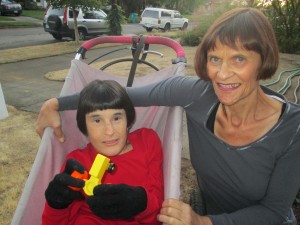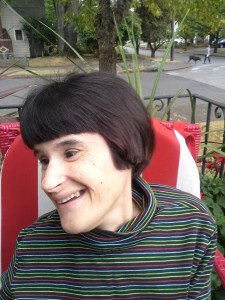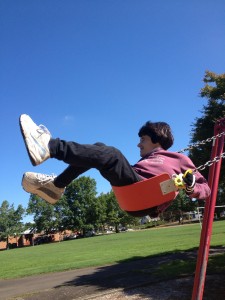
Meet Molly Drummond
Molly Drummond is one of the original plaintiffs in the Staley lawsuit, when several Oregon families sued the State of Oregon in 2000 for unreasonably denying necessary services to adults with intellectual and developmental disabilities. The court case resulted in a settlement from which Oregon brokerage services originated. At the time, Molly, and five thousand or so adults with developmental disabilities who lived in family homes, were entirely without disability services.
“We’re not really suing kind of people, but I thought, no, doggone it, this really needs to happen!” said Diann Drummond, Molly’s mother. Molly was 23 at the time, and Diann was already deeply involved in the professional community of developmental disability networks through her job as the Portland Public Schools special education family liaison and her work with the developmental disability newsletter, The Clarion. Although the act of suing the State of Oregon might sound contentious, explained Diann, it was actually a large, collaborative effort. “Everybody was on board… all the parties agreed the wait list problem needed to be resolved.”
At the time of the lawsuit, the only adults with intellectual disabilities who received state-funded services were those in out-of-home placements such as comprehensive services (for example, a residential group home) or crisis situations. Adults who lived in family homes or lived independently, amounting to thousands of individuals, were on a wait list for services. “It was called it a wait list, but it was really a no-service list,” Diann said. “Our sons and daughters wanted services, but without the out-of-home placement.” Diann was adamant that Molly stay living at home. “I am not going to choose an out-of-home placement for her!” she remembers thinking.
The Oregon Brokerage System was founded as a result of the Staley Settlement. “It brought the choice of community-level services to everyone who was eligible for developmental disability services,” explained Diann. “It was a new model for providing services… self-determination and self-directed supports…Oregon is really a pioneer in that self-directed, individualized service model…. So that was huge!” It was in 2002, when Molly was 24, that she began receiving services through Oregon’s first brokerage. “We wanted her in a day activity program… I wanted transportation and respite. Those were the things that went on the first plan for Molly. Over the years we adjusted the plan for Molly as things came up.”
Molly was born with Trisomy 18, an extra eighteenth chromosome, which caused Molly to have an intellectual disability and an extreme curvature of the spine. Because Trisomy 18 can have severe medical complications, only around ten percent of children born with this genetic condition live past their first year. Grappling with a short life expectancy, Diann had to make many extraordinarily difficult decisions about Molly’s health care, including the decision to remove a painful steel rod from Molly’s back after multiple surgeries when she was a young child. Molly entered the Portland Public Schools’ chronically ill program and was “sick all the time—the most medically fragile person you can imagine,” said Diann. Things changed when, at about age eight “she just thrived!” and was ready to go to an integrated classroom at her neighborhood school. Suddenly, she “blossomed in her development all the way… of course over the years I had worried… most people don’t live with that degree of curvature,” said Diann. Yet Molly’s good health continued throughout her school years.
As a young adult Molly experienced a traumatic event that resulted in the eventual need for Molly to take medications to help her manage self-injurious behaviors. These medications caused Molly, who had always been very light, to put on weight, and at that same time, Molly began experiencing difficulty with breathing. Diann thought, “it’s happening— this is it. She is going to die because of her scoliosis…” Dianne prepared a POLST (Physician’s Orders for Life Sustaining Treatment, an instruction sheet for end-of-life planning) and says that she stayed focused on Molly’s quality of life, not length of life. “In the meantime,” recalled Diann, “it was time to take her off the medication. She lost the weight and never had another incident [of breathing difficulty].” Whereas other families of kids with special needs were worried about their child’s future and long-term care plans, Diann said this particular worry was one she was spared, until, as the years continued passing, she thought, “I am beginning to wonder!” Now Molly is 38 years old and in robust health. “She’s skinny, tiny and active… most people who have that level of curvature might be immobile,” said Diann, “so she is amazing!” “Nobody ever expected her to live to 38 years… She has got to be the oldest Trisomy 18 person in the world!” Diann exclaimed.
Molly is a petite woman standing about 4 feet tall and weighing 64 pounds. Her mom describes her as “an interesting, interactive, happy person” who loves music, dancing, and riding or moving on anything, even carnival rides. She is “a wild thing on those rides at Oaks Park,” says Diann. She loves to go in her jogger, which Diann pushes while she runs every day. If Molly wishes to go out in her jogger, she goes to the front door of her home to get the small tire pump for the jogger wheels and gives it to Diann. Molly also loves manipulating objects, “things that have pieces, like the tractor with wheels.”
Though Molly does not speak per se, she vocalizes for long periods, and often in tandem with her mother’s speech. Molly will break into laughter when her mom laughs. At times Molly will speak “clear as a bell,” surprising Diann and others who know Molly well. Diann says, “She has great receptive language, I can say first we do this, and then we do that, and she can process it and go through those steps. And so she surprises me sometimes with her receptive language.”
Though Molly was one of the first customers of the Oregon brokerage system, her services switched to county comprehensive services when several years ago her needs exceeded the funding that was available from brokerage services. But in 2014, when a new needs assessment was implemented across both service systems, the door was open for Molly to rejoin the brokerage system. Her service hours, determined by the needs assessment, would now be the same regardless of which service system oversaw Molly’s service plan. Diann and Molly chose to initiate a change to Independence Northwest Brokerage, which now manages Molly’s services. “So now we’re with the brokerage and I cannot tell you how happy we are.” Diann describes brokerage philosophy as “all about making thing work.” Diann thinks Molly may be the first customer who, as a result of the restructuring of Oregon developmental disability services, has switched from county to brokerage services. “The brokerage completely facilitated a very complicated process for us! About how to transfer to the brokerage and maintain continuity of services.” This process was new ground not only for Molly and Diann, but for the brokerage as well. Diann commented, “It was new for them, but they stay up to date with everything going on. It can be confusing… but they really do a nice job of facilitating change-over.”
!["[Brokerages] brought the choice of community-level services to everyone who was eligible for developmental disability services.”](http://independencenw.org/wp-content/uploads/2015/11/mollyjogger-300x225.jpg)
“[Brokerages] brought the choice of community-level services to everyone who was eligible for developmental disability services.”
Since joining Independence Northwest, Diann says, “I have been so happy!” She and Molly are pleased with their service plan, providers, and “happy knowing there is flexibility if your need change.” Diann has also joined the Independence Northwest Board of Directors. “I am the biggest booster for the brokerages as there as ever was!”
Text by Molly Mayo
Photos by Molly Mayo and Diann Drummond



